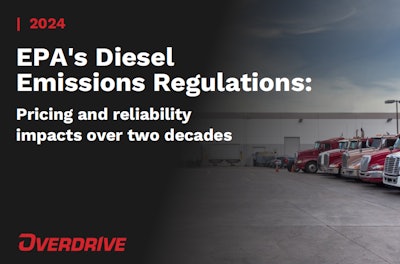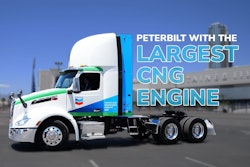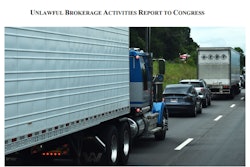Stephen Halsted, owner of a 2016 Freightliner straight truck custom-built for the expediting business, is no stranger to emissions-systems maintenance. Most work he's had to do he calls “standard” maintenance, yet a cracked diesel particulate filter was another story.
He'd hoped to be able to keep the original filter "and just basically do the cleanings,” he said, yet replacement was the result. Since then, "all I've had to do is clean them," not an inexpensive proposition, he added. He's replaced NOx sensors in the selective catalytic reduction system -- three times in 800,000 miles for the 2016 unit since he bought it new. (His repair shop has been in touch with Freightliner about that issue, he added, but that hasn’t resulted in any real resolution to the repeat problem.)
Halsted's experience is shared by legions of owners of truck equipment outfitted with emissions control systems built in response to successive rounds of tighter and tighter Environmental Protection Agency regulations limiting diesel exhaust's particulate matter, oxides of nitrogen (NOx) and more. The "sticker shock" impact of all those regulations for Class 8 truck buyers, as reported in first part of this series, isn't the only significant outcome.
Part 1: EPA 2027 diesel emissions regs: Class 8 truck price hikes in the offing
According to respondents to an early-2024 survey of Overdrive readers, compounding maintenance headaches have been just as significant a result over two decades' worth of emissions regulations.
With the next emissions round quickly approaching with the 2027 model year, when EPA's latest NOx-reduction regs take full effect, the survey showed maintenance headaches named by 65% of survey respondents as the most impactful result of emissions regulations, right alongside truck price inflation.
Past reliability issues leave many owners wary of EPA 2027 -- that includes Halsted. As he put it, “I would not buy a 2027 model, a 2028 or 2029,” he said. "I’m not gonna be a guinea pig where I’ve got a $4,000-$5,000-a-month truck payment, and where’s the truck?
"Always sitting in the shop.”
 Stephen Halsted and business partner Sandy Goche operate in this 2016 Freightliner Cascadia straight truck, leased to Landstar and hauling expedited freight across the country. Halsted chalked up his expensive cracked-DPF replacement to the quality, or lack thereof, of certain highways across the country.Stephen Halsted
Stephen Halsted and business partner Sandy Goche operate in this 2016 Freightliner Cascadia straight truck, leased to Landstar and hauling expedited freight across the country. Halsted chalked up his expensive cracked-DPF replacement to the quality, or lack thereof, of certain highways across the country.Stephen Halsted
Even with the truck under warranty, all the downtime can be a killer for an owner-operator, he noted. “There’s no income coming in to make the truck payment.”
As noted in prior reporting, Congress put a revocation of EPA 2027 on the president's desk last year, but that's where it ended. President Biden vetoed the rollback.
Based on survey responses, other maintenance-related issues were also identified as of chief concern to owner-operators asked to name the most impactful emissions-regs-related outcomes -- 60% earmarked increasingly complicated diagnosis of equipment problems, 42% Halsted's downtime concern, as repairs have taken longer and longer to complete.
When owners assessed their own most recent truck's reliability on a scale of 1-10, average ratings bottomed out for the 2011-'14 model year group, the first generation of engines featuring selective catalytic reduction with the use of diesel exhaust fluid.
While owner-operators’ experience of more recently built equipment yields lower average reliability ratings than for equipment from the early-2000s, reliability generally seems to have been on the uptick with recent-history rounds of emissions regulations.
To meet EPA 2027 regs, OEMs are "trying to invent something to accomplish a very specific goal under such a short timeframe. And it's not easy to get accomplished.” --Scott Pearson, American Truck Dealers chairman
With new aftertreatment equipment on the way, the positive trend over the last decade could be a sign of lessons learned by truck and engine manufacturers, and truck owners themselves, about how to produce and keep running reliably increasingly complex emissions systems. At once, as American Truck Dealers Chairman and Peterbilt of Atlanta President Scott Pearson put it in the first story in this series, “I haven’t seen a new emission system that came out and was 100% reliable.”
There may still be headaches to come.
No. 1 biggest maintenance item since 2008-'10 generation trucks: Emissions systems
Across all model years, the biggest area of maintenance expense for owner-operators’ latest truck purchases is the routine needs that every truck owner encounters. Yet not far behind, according to Overdrive survey results, are expenses related to the emissions system and its components. There’s a big drop-off after that, with just 14% of respondents indicating an engine rebuild or other engine work.
Emissions systems maintenance was at the very top of the list as the biggest area of maintenance expense for every model year group from 2008-'10 trucks and on to the present.
Joel Morrow, co-owner of Alpha Drivers Transportation and owner of Alpha Drivers Testing & Consulting, said the early-era emissions trucks caused the biggest headaches because “nobody knew anything, and we were just spec’ing trucks like we always had spec’d” them, he said. “Before we really started to get educated and understand how the emissions” worked, “that was painful. It was. ... The rear axle ratios were wrong, and just a lot of stuff was wrong.”
Since then, however, Morrow said he’s been “super aggressive” with preventive maintenance, doing early replacements of boost-pressure sensors, cleaning EGR coolers, generally doing things “proactively to avoid the downtime, which is expensive in and of itself.”
Small fleet owner Doug Newman, with three trucks leased to K&J Trucking, is no stranger to such downtime, with early-era emissions-system issues encountered out on the road. You can add extra travel expenses to the lost opportunity, too.
Perhaps the start of his issues were with a DPF that left a unit broken down far from home base and needing to have the filter cleaned to remove soot. He drove from South Dakota to Nashville in his pickup to get his driver back home, then flew the trucker back down when the rig was repaired. To make matters worse, the driver was under a load at the time. Newman had another K&J operator dispatched to retrieve the load.
That breakdown cost him not only the downtime, travel expense and repair cost, but also the revenue on the load the truck was under at the time.
Newman feels reliability of emissions equipment has improved since around 2015-2016, models he said “really struggled.” Even with that improvement, he still takes issue with the design/cost of servicing the DPF. “It would make way more sense if they would make a replaceable filter at a reasonable cost,” he said. “How hard could it really be to make it to where you can open up this canister, pull out the old filter and put a new one in. Or put in a refurbished one that’s been baked [for soot removal] already."
That can in fact be done today, yet service shops and manufacturers "should make it easier, and cheaper,” Newman added.
“I don’t want to be one of the first ones to own a new truck with the new emissions. When they first came out with the DPF, they were constantly having problems, so I will avoid it like the plague.” --Small fleet owner Doug Newman
[Related: The top 5 diesel fault codes, and emissions issues you can do something about]
The way Morrow sees it, while OEMs did have some hiccups early on with emissions equipment, those early systems were still “viable if spec’d and operated correctly,” he said. Education on properly spec’ing an emissions system-equipped truck is something he sees that’s lacking around trucking. There's been a real reluctance, too, to move away from the “legacy spec” of an 18-speed transmission with 3.55 or 3.70 rears and high-horsepower engines.
“That kind of legacy spec dies hard for whatever reason,” he said.
As detailed in the first part of this series, Morrow feels that, fundamentally, apart from past persnickety emissions issues in those early years, trucks and engines are far more reliable today than when he was growing up. Owner-operator Henry Albert echoed the sentiment, noting how common in-frame overhauls were when he started his career -- every 500,000 miles or so, he said. Today, “if it doesn’t make it to a million [miles], people have a problem with it.”
 Vincent CrisantiTrucking Solutions Group
Vincent CrisantiTrucking Solutions Group
Crisanti has owned the ’98 since 2017 and said it’s been “extremely reliable,” tracking with the high rating of pre-2000 trucks reported by owners in Overdrive’s emissions survey. Asked to choose model year groups with the best and worst reliability reputations, too, very few named those pre-2000 trucks worst, as shown below.
 This graph shows the shares of Overdrive survey responses to the question of which model year group had the absolute worst reliability reputation. Can you guess which group most owner-operators named the best? Download the full report to find out.
This graph shows the shares of Overdrive survey responses to the question of which model year group had the absolute worst reliability reputation. Can you guess which group most owner-operators named the best? Download the full report to find out.
Owner Crisanti's 2023 has only been on the road for a year and a half, and the only out-of-the-ordinary issue he’s seen with it so far has been the truck throwing false, non-emissions-related codes occasionally. He's well aware of the kinds of issues that can be experienced with the systems, though. He previously owned 2017 Freightliner Cascadia -- he had to replace the DPF, then a NOx sensor went out, derating the engine while he was under a load of livestock.
He lucked out in that situation -- the dealership he pulled into had a rental available to keep the livestock rolling.
 Shane Rizzuto's 2022 Mack AnthemTrucking Solutions Group
Shane Rizzuto's 2022 Mack AnthemTrucking Solutions Group
ATD’s Pearson noted, however, that to meet new standards OEMs are “trying to invent something to accomplish a very specific goal under such a short timeframe,” regarding emissions regulations. “And it's not easy to get accomplished.”
'Skepticism' is the watchword for EPA 2027 regs
New aftertreatment equipment will be standard, it's certain, with full 2027 implementation. Owner-operators remain skeptical about "guinea pig" dynamics owner Halsted noted when it comes to reliability.
As reported, more than one OEM's talking about larger-volume aftertreatment systems, a 48-volt generator to power an electrical heater to provide lower NOx output, and other changes.
Halsted said he's considered building a new truck in recent times to get ahead of the changes. The lead time required to spec out and build a truck for expedited work means he's already behind the eight ball there. "You’ve got to pretty much start two years out," he said. "So we would be falling in probably the 2027s.”
He’s decided, instead, to keep what he has for now.
2027 skeptics might invest in "a 2024 or 2025. ... We know a lot about them nowadays, and especially if you spec them right, you can expect some just excellent fuel efficiency and reliability out of them.”
--Joel Morrow
K&J Trucking-leased owner-operator Theron Thompson would advise similarly if you couldn't get one before the regulations change, he said. “I don’t want to be the guinea pig out there and put myself in a spot where I go bankrupt.”
Small fleet owner Newman, too: “I don’t want to be one of the first ones to own a new truck with the new emissions,” he said. “When they first came out with the DPF, they were constantly having problems, so I will avoid it like the plague.”
Newman likes a four-year replacement cycle for his trucks and buys them with an extended warranty. When he sells them, they’re still under warranty, adding resale value. He wants to expand from three to four trucks, then stay at that size and buy one/sell one each year. With emissions changes coming, “that might be another time period where I’m going to hold onto the trucks maybe an extra one or two years until they get this figured out," he said. "I don’t have any faith in, I’ll just say, the OEMs. Is it their fault? No, not necessarily. It’s the government putting on … overly restrictive guidelines.”
Not all owners are as concerned about the 2027 changes. Mark Heggestad, leased to Carrell Trucking, said emissions regs just aren't a “factor in my decisions going forward. Not that it’s not important. It is highly important. But I don’t think I’ll look at it any differently in 2027 when the new emissions come into play than I did when I ordered my truck,” -- a 2019 Freightliner Cascadia that he spec’d out for fuel efficiency.
 Heggestad operates in this 2019 Freightliner CascadiaTrucking Solutions Group
Heggestad operates in this 2019 Freightliner CascadiaTrucking Solutions Group
Owner-operator Morrow, who works closely with Volvo Trucks in maximizing efficiency with his Alpha Drivers Testing & Consulting business, said he will likely have a truck with one of the first 2027-compliant engines Volvo puts out, but he knows that’s not for everybody.
If an owner “is in a truck, say a 2008 or 2010, or maybe a pre-emissions truck, going right to the newest stuff in 2027 may not be the best idea," he offered by way of advice. "But grabbing something that’s a 2024 or 2025 may be a very good idea for them. These are pretty damn reliable. We know a lot about them nowadays, and especially if you spec them right, you can expect some just excellent fuel efficiency and reliability out of them.”
Find reliability ratings and pricing impacts for various generations of diesels over the decades, and more perspective, in the survey report, EPA's Diesel Emissions Regulations: Pricing and reliability impacts over two decades.
[Related: In a tough trucking business environment, owner-operators must improve efficiency to compete]











